A Study to Investigate Fluid-Solid Interaction Effects on Fluid Flow in Micro Scales
Abstract
:1. Introduction
2. Establishment of a Novel Model Considering Fluid-Solid Interaction
2.1. Construction of Modified Hagen-Poiseuille’s Formula
2.2. Establishment of Boundary Layer Thickness Expression
2.2.1. Micro Tube Experiment
2.2.2. Representation of Boundary Layer Thickness
3. Validation and Application Range Analysis of the Model
3.1. Validation of the Model
3.2. Application Range Analysis of the Model
4. Fluid-Solid Interaction Effects on Microscopic Flow
4.1. Velocity Profile
4.2. The Average Flow Velocity
4.3. Flow Resistance
4.4. Pore Scale Network Model
5. Conclusions
- When fluid-solid interaction is taken into consideration, the velocity in micro tube is smaller than that predicted by traditional Hagen-Poiseuille’s law. The fluid-solid interaction declines significantly as the distance away from the solid wall grows larger, which results in largest velocity deviation near the wall surface and the smallest one in the center of micro tube.
- Non-linear flow occurs both in micro tubes and porous media at low displacement pressure gradient due to fluid-solid interaction. Moreover, the effect of fluid-solid interaction on micro flow declines with increased displacement pressure gradient, which leads to smaller and smaller velocity deviation.
- The changing rules of the Reynolds number, the Resistance coefficient and Poiseuille number do not obey traditional Hagen-Poiseuille’s law owing to fluid-solid interaction. The smaller the radius and the lower the displacement pressure gradient, the stronger the fluid-solid interaction, the larger the deviation will be.
- The apparent permeability in porous media is no longer a constant when incorporating the novel model into pore scale network model. The apparent permeability increases and the permeability deviation declines with increased displacement pressure gradient.
Author Contributions
Acknowledgments
Conflicts of Interest
References
- Clarkson, C.R.; Pedersen, P.K. Tight oil production analysis: Adaptation of existing rate-transient analysis techniques. In Proceedings of the Canadian Unconventional Resources and International Petroleum Conference, Calgary, AB, Canada, 19–21 October 2010. [Google Scholar]
- Du, J.H.; He, H.Q.; Yang, T.; Huang, F.X.; Guo, B.C.; Yan, W.P. Progress in China’s tight oil exploration and challenges. China Pet. Exp. 2014, 19, 1–9. [Google Scholar]
- Lin, S.H.; Zou, C.N.; Yuan, X.J.; Yang, Z. Status quo of tight oil exploitation in the United States and its implication. Lithol. Reserv. 2011, 23, 25–30. [Google Scholar]
- Cui, X.; Bustin, A.M.M.; Bustin, R.M. Measurements of gas permeability and diffusivity of tight reservoir rocks: Different approaches and their applications. Geofluids 2009, 9, 208–223. [Google Scholar] [CrossRef]
- Liu, Y.F.; Hu, W.X.; Cao, J.; Wang, X.L.; Tang, Q.S.; Wu, H.G.; Kang, X. Diagenetic constraints on the heterogeneity of tight sandstone reservoirs: A case study on the Upper Triassic Xujiahe Formation in the Sichuan Basin, southwest China. Mar. Pet. Geol. 2018, 92, 650–669. [Google Scholar] [CrossRef]
- Lyu, C.H.; Ning, Z.F.; Wang, Q.; Chen, M.Q. Application of NMR T2 to pore size distribution and movable fluid distribution in Tight Sandstones. Energy Fuels 2018, 32, 1395–1405. [Google Scholar] [CrossRef]
- Zhao, H.W.; Ning, Z.F.; Wang, Q.; Zhang, R.; Zhao, T.Y.; Niu, T.F.; Zeng, Y. Petrophysical characterization of tight oil reservoirs using pressure-controlled porosimetry combined with rate-controlled porosimetry. Fuel 2015, 154, 233–242. [Google Scholar] [CrossRef]
- Wang, F.; Liu, Z.; Jiao, L.; Wang, C.; Guo, H.U. A fractal permeability model coupling boundary-layer effect for tight oil reservoirs. Fractals 2017, 25, 1750042. [Google Scholar] [CrossRef]
- Wu, J.S.; Hu, D.Z.; Li, W.J.; Cai, X. A review on non-Darcy flow u2014 forchheimer equation, hydraulic radius model, Fractal model and experiment. Fractals-Complex Geom. Patterns Scaling Nat. Soc. 2016, 24, 1782–1788. [Google Scholar]
- Soroori, S.; Rodriguez-Delgado, J.M.; Kido, H.; Dieck-Assad, G.; Madou, M.; Kulinsky, L. The use of polybutene for controlling the flow of liquids in centrifugal microfluidic systems. Microfluid. Nanofluid. 2016, 20, 26. [Google Scholar] [CrossRef]
- Guo, J.S.; Huang, B.C. Hyperbolic quenching problem with damping in the micro-electro mechanical system device. Discret. Contin. Dyn. Syst. 2014, 2. [Google Scholar] [CrossRef]
- Campo-Deaño, L. Fluid-Flow Characterization in Microfluidics. In Complex Fluid-Flows in Microfluidics; Galindo-Rosales, F.J., Ed.; Springer International Publishing: New York, NY, USA, 2018; pp. 53–71. [Google Scholar]
- Kavallaris, N.I.; Suzuki, T. Micro-electro-mechanical-systems (MEMS). In Non-Local Partial Differential Equations for Engineering and Biology: Mathematical Modeling and Analysis; Springer International Publishing: New York, NY, USA, 2018; pp. 3–63. [Google Scholar]
- Ho, C.M.; Tai, Y.C. Micro-electro-mechanical-systems (MEMS) and fluid flows. Annu. Rev. Fluid Mech. 1996, 30, 579–612. [Google Scholar] [CrossRef]
- Wang, F.; Yue, X.; Xu, S.; Zhang, L.; Zhao, R.; Hou, J. Influence of wettability on flow characteristics of water through microtubes and cores. Chin. Sci. Bull. 2009, 54, 2256–2262. [Google Scholar] [CrossRef]
- Yue, X.A.; Wang, N.; Zhang, L.J.; Wang, F. Flow experiments of HPAM solution in quartz micro-tubes. Mech. Eng. 2010, 32, 81–84. [Google Scholar]
- Ling, Z.Y.; Ding, J.N.; Yang, J.C.; Fan, Z.; Li, C.S. Research Advance in Microfluid and Its Influencing Factors. J. Jiangsu Univ. Sci. Technol. 2002, 6, 1–5. [Google Scholar]
- Li, Z.H.; Cui, H.H. Characteristics of Micro Scale Flow. J. Mech. Strength 2001, 4, 476–480. [Google Scholar]
- Pfahler, J.; Harley, J.; Bau, H.; Zemel, J. Liquid transport in micron and submicron channels. Sens. Actuators A Phys. 1990, 22, 431–434. [Google Scholar] [CrossRef]
- Makihara, M.; Sasakura, K.; Nagayama, A. The Flow of Liquids in Micro-Capillary Tubes: Consideration to Application of the Navier-Stokes Equations. J. Jpn. Soc. Precis. Eng. 1993, 59, 399–404. [Google Scholar] [CrossRef]
- Qu, M.L.; Mala, M.; Li, D.Q. Pressure-driven water flows in trapezoidal silicon microchannels. Int. J. Heat Mass Transf. 2000, 43, 353–364. [Google Scholar] [CrossRef]
- Wu, J.Z.; Cheng, L.S.; Li, C.L.; Cao, R.Y.; Chen, C.C.; Cao, M.; Xu, Z.Y. Experimental study of nonlinear flow in micropores under low pressure gradient. Transp. Porous Media 2017, 119, 247–265. [Google Scholar] [CrossRef]
- Sandeep, A.; Saleem, K.; Akhil, V.; Harneet, K.; Parveen, L. Microfluidic mechanics and applications: A review. J. Nano-Electron. Phys. 2013, 5, 04047-1. [Google Scholar]
- Gad-El-Hak, M. The Fluid Mechanics of Micro-devices—The Freeman Scholar Lecture. ASME J. Fluids Eng. 1999, 121, 5–33. [Google Scholar] [CrossRef]
- Zhang, X.L.; Zhu, W.Y.; Cai, Q.; Liu, Q.P.; Wang, X.F.; Lou, Y. Analysis of weakly compressible fluid flow in nano/micro-size circular tubes considering solid wall force. Acta Sci. Nat. Univ. Pekin. 2014, 36, 569–575. [Google Scholar]
- Мархасин, И.Л. Physical and Chemical Mechanism of Reservoir; Petroleum Industry Press: Beijing, China, 1987. [Google Scholar]
- Pertsin, A.; Grunze, M. Water-graphite interaction and behavior of water near the graphite surface. J. Phys. Chem. B 2004, 108, 1357–1364. [Google Scholar] [CrossRef]
- Mazzoco, R.R.; Wayner, P.C. Aqueous Wetting Films on Fused Quartz. J. Colloid Interface Sci. 1999, 214, 156–169. [Google Scholar] [CrossRef] [PubMed]
- Liu, D.X.; Yue, X.A.; Hou, J.R.; Wang, L.M. Experimental Study of Adsorbed Water Layer on solid particle surface. Acta Miner. Sin. 2005, 1, 15–19. [Google Scholar]
- Huang, Y.Z. Infiltration Mechanism of Low-Permeability Reservoir; Petroleum Industry Press: Beijing, China, 1999. [Google Scholar]
- Li, Y. Study of Microscale Nonlinear Flow Characteristics and Flow Resistance Reducing Methods. Ph.D. Thesis, Institute of Porous Flow and Fluid Mechanics, Lanfang, China, 2010. [Google Scholar]
- Wu, J.Z.; Cheng, L.S.; Li, C.L.; Cao, R.Y.; Chen, C.C.; Xu, Z.Y. Flow of Newtonian fluids with different polarity in micro scale. Chin. Sci. Bull. 2017, 62, 2988–2996. [Google Scholar]
- Xu, S.; Yue, X.; Hou, J. Experimental study on the flow characteristics of deionized water in microcircular tubes. Chin. Sci. Bull. 2007, 6, 120–124. [Google Scholar]
- Zhu, C.J.; Zhang, J.; Zhang, P. Study on Influence of Boundary Layer on the Non-Darcy Seepage Law. J. Converg. Inf. Technol. 2013, 8, 960–968. [Google Scholar]
- Zhang, P.; Zhang, L.Z.; Li, W.Y.; Wang, Y.F. Experiment on the influence of boundary layer on the Non-Darcy seepage law. J. Hebei Univ. Eng. 2008, 25, 70–72. (In Chinese) [Google Scholar]
- Thomas, J.A.; McGaughey, A.J.H. Reassessing fast water transport through carbon nanotubes. Nano Lett. 2008, 8, 2788–2793. [Google Scholar] [CrossRef] [PubMed]
- Li, Z.F.; He, S.L. Influence of boundary layers upon filtration law in low-permeability oil reservoirs. Pet. Geol. Oilfield Dev. Daqing 2005, 24, 57–59, 77–107. [Google Scholar]
- Liu, W.D.; Liu, J.; Sun, L.H.; Li, Y.; Lan, X.Y. Influence of Fluid Boundary Layer on Fluid Flow in Low Permeability Oilfields. Sci. Technol. Rev. 2011, 29, 42–44. [Google Scholar]
- Cao, R.Y.; Wang, Y.; Cheng, L.S.; Ma, Y.Z.; Tian, X.F.; An, N. A New Model for Determining the Effective Permeability of Tight Formation. Transp. Porous Media 2016, 112, 21–37. [Google Scholar] [CrossRef] [Green Version]
- Wu, J.Z.; Cheng, L.S.; Cao, R.Y.; Xu, Z.Y.; Ding, G.Y.; Ding, G.Y. A Novel Characterization of Effective Permeability of Tight Reservoir—Based on the Flow Experiments in Microtubes. In Proceedings of the 19th European Symposium on Improved Oil Recovery, Stavanger, Norway, 23–28 April 2017. [Google Scholar]
- Tian, X.F. Non-Linear Flow Behavior and Mathematical Model in Ultra-Low Permeability Reservoirs. Ph.D. Thesis, China University of Petroleum (Beijing), Beijing, China, 2015. [Google Scholar]
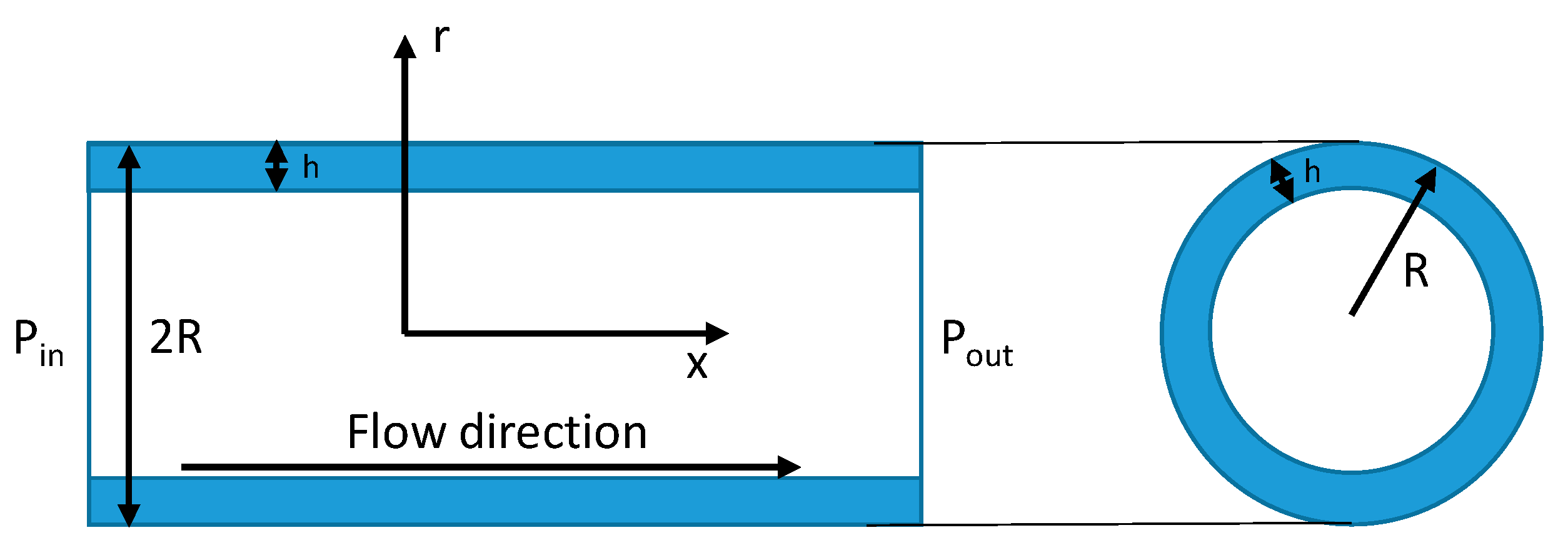
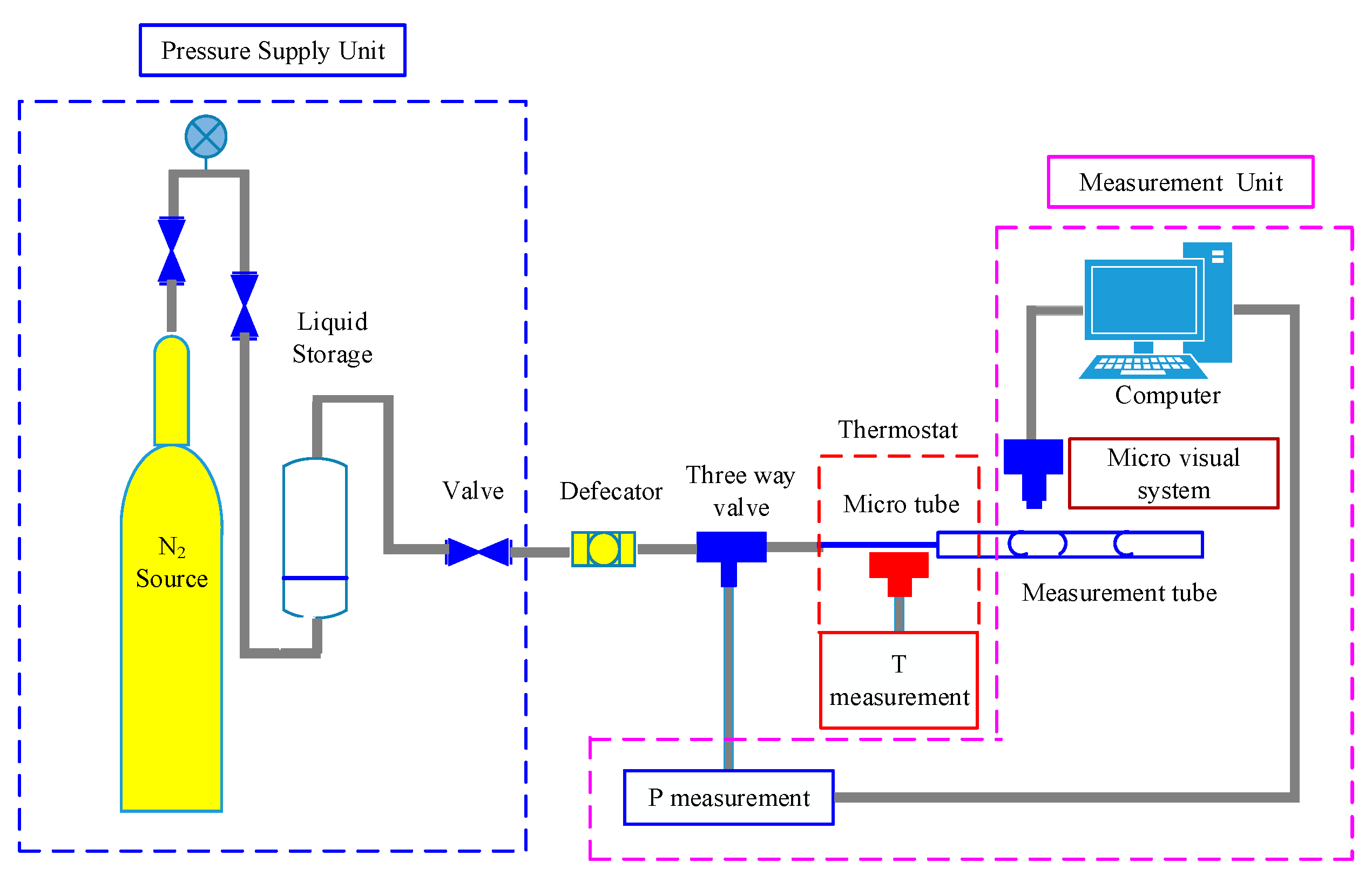
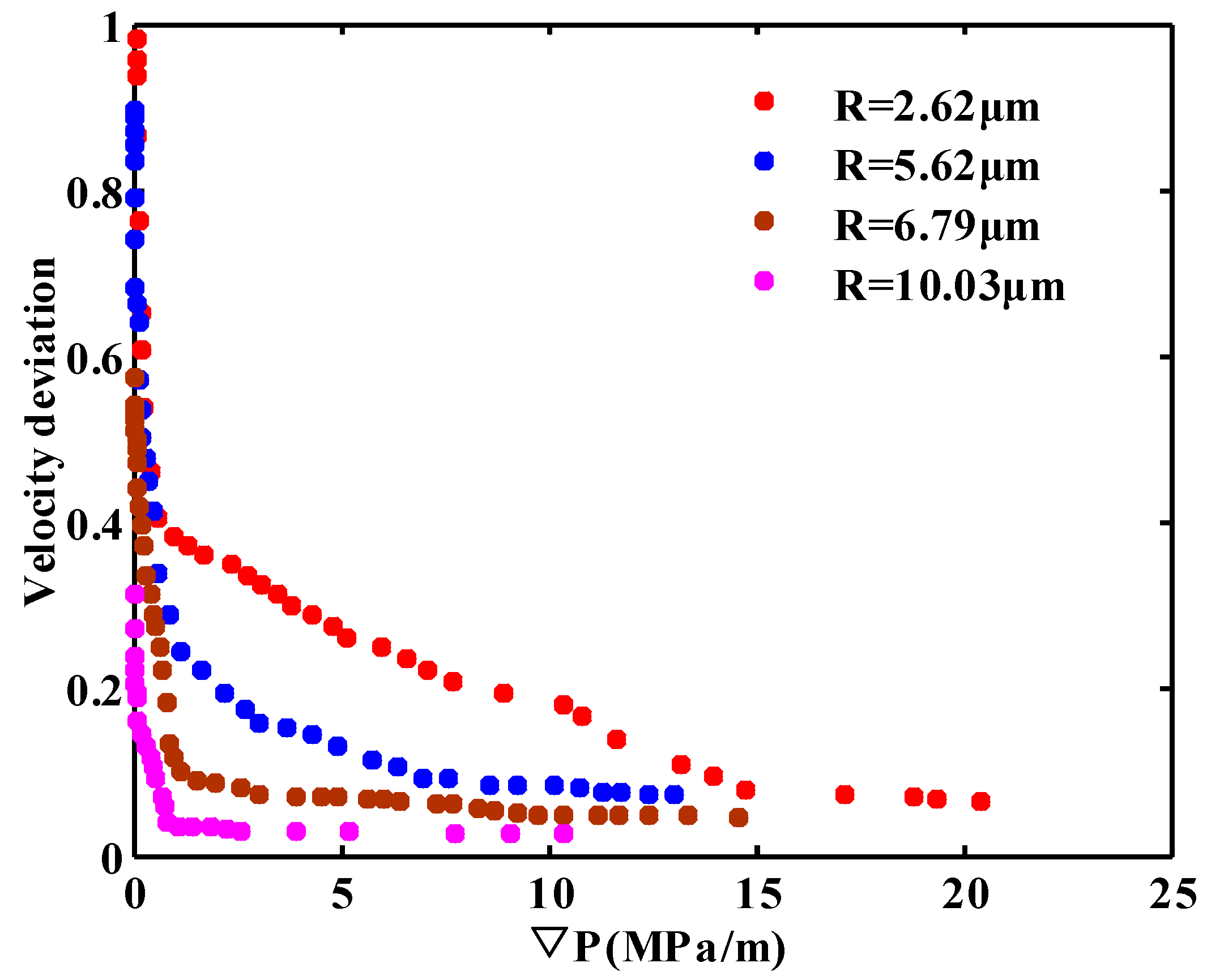

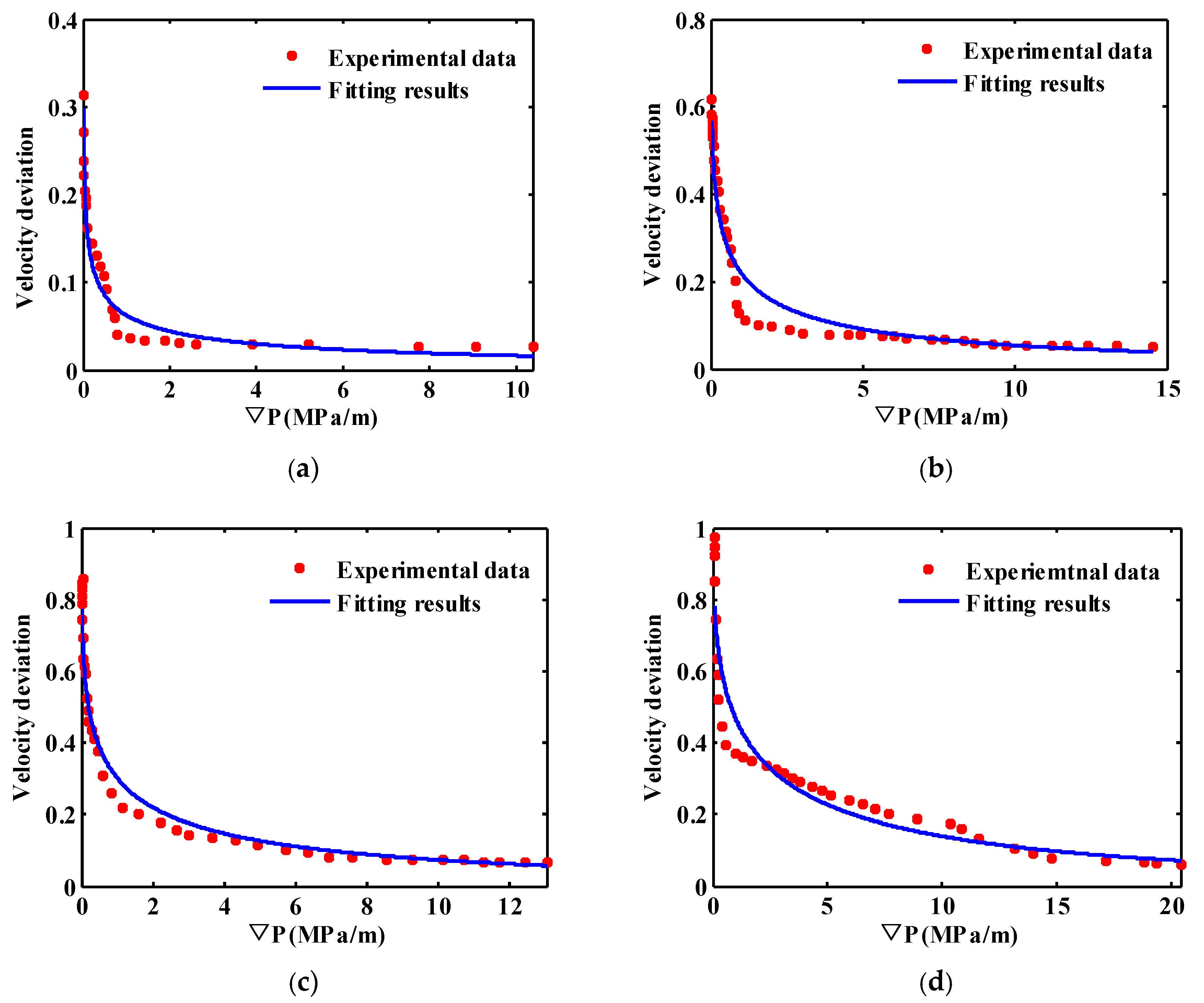




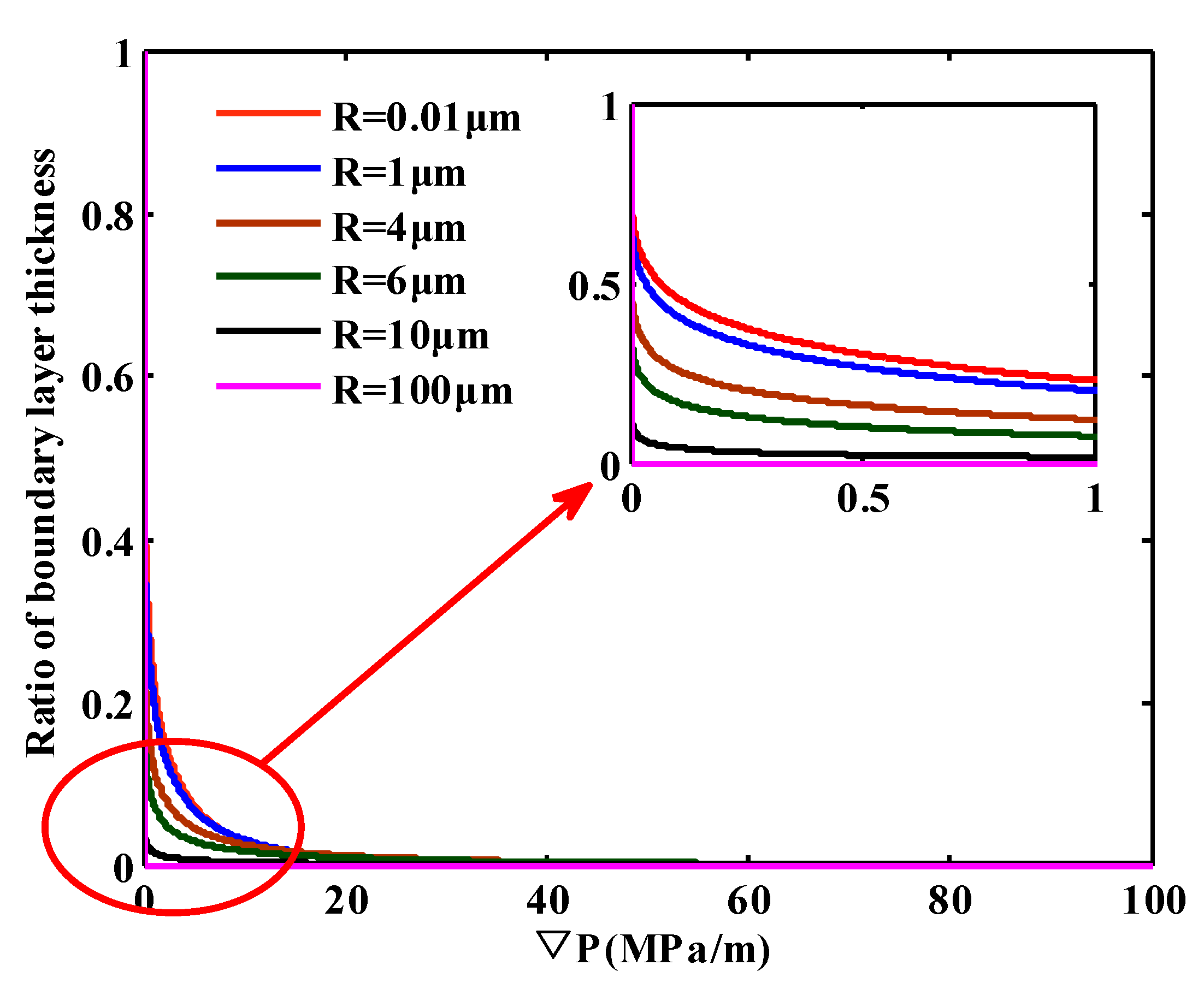
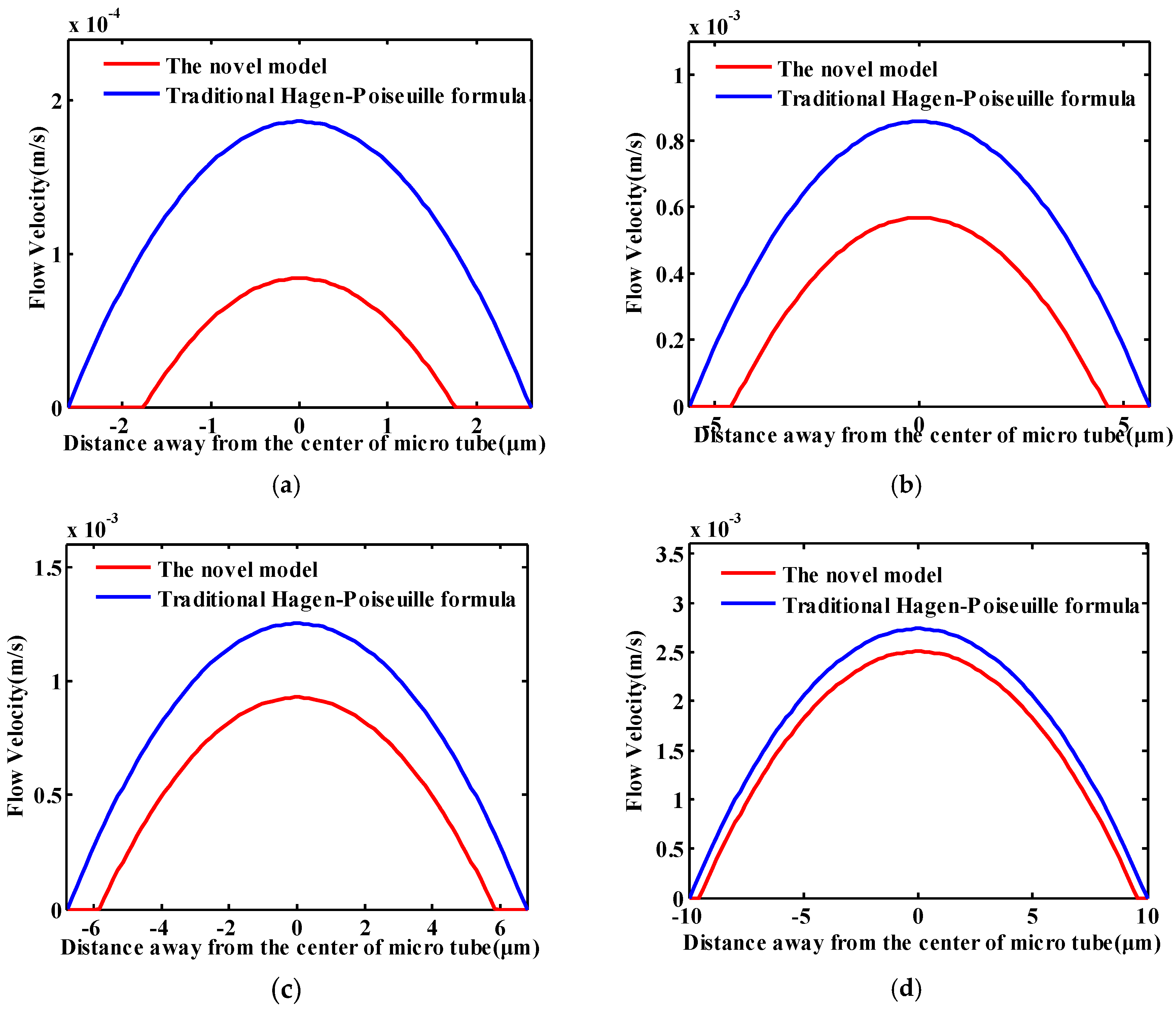
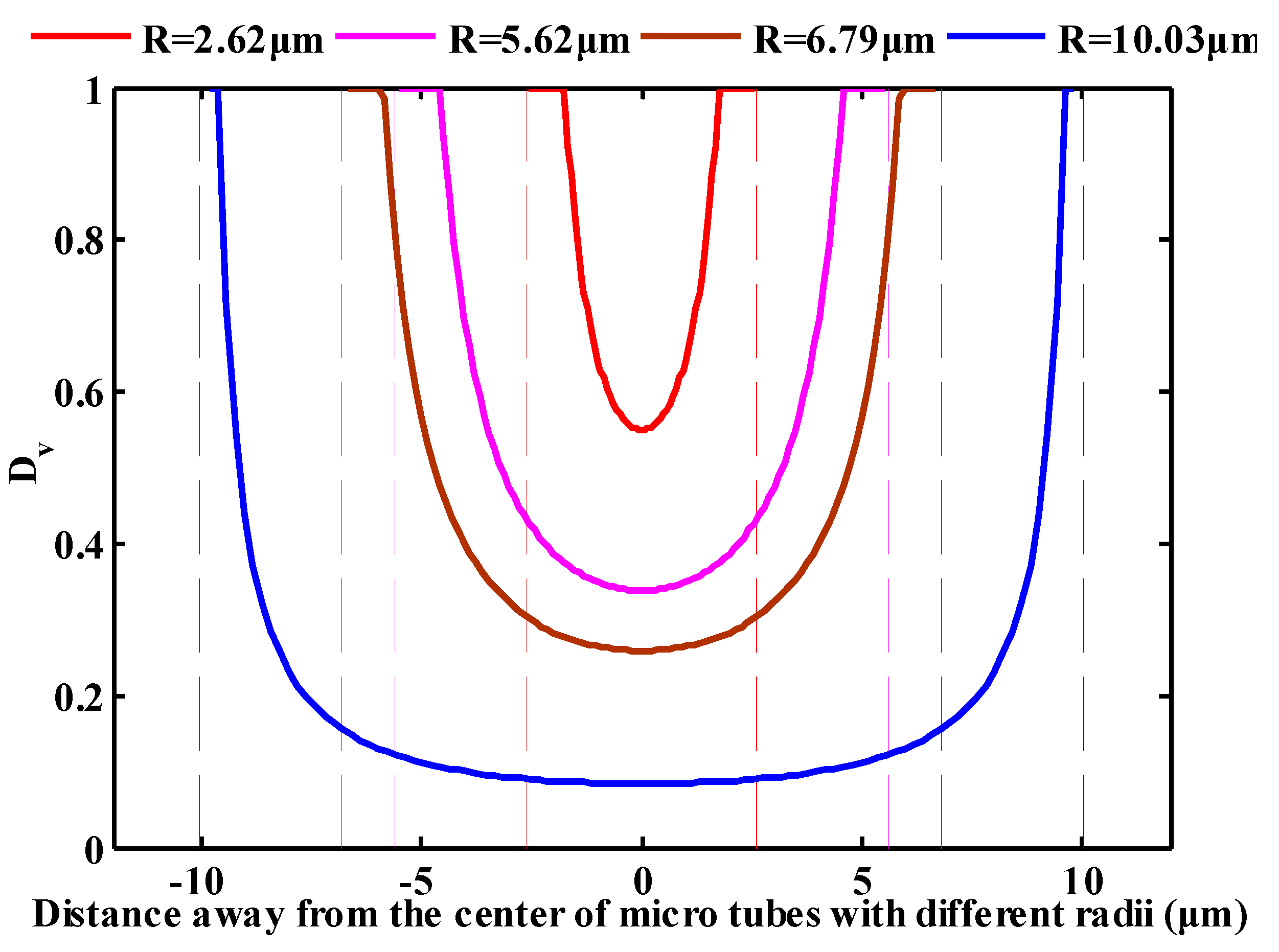

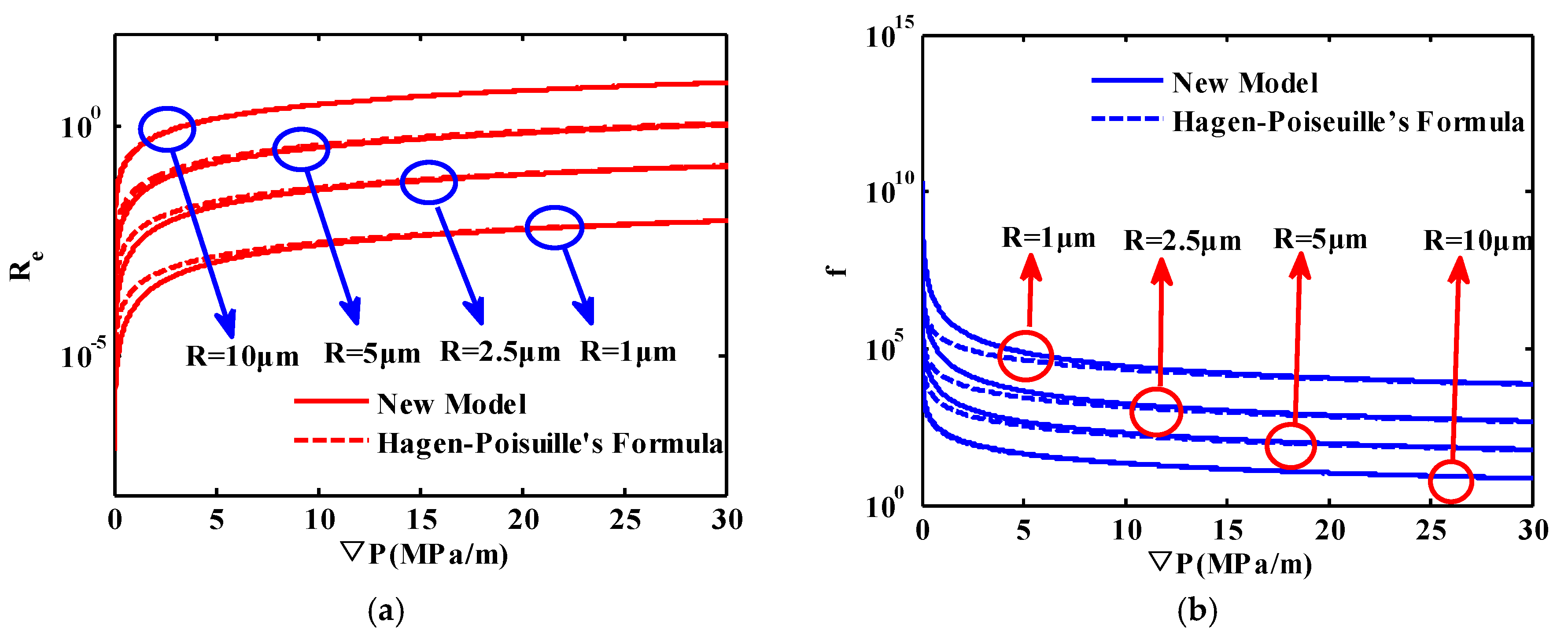

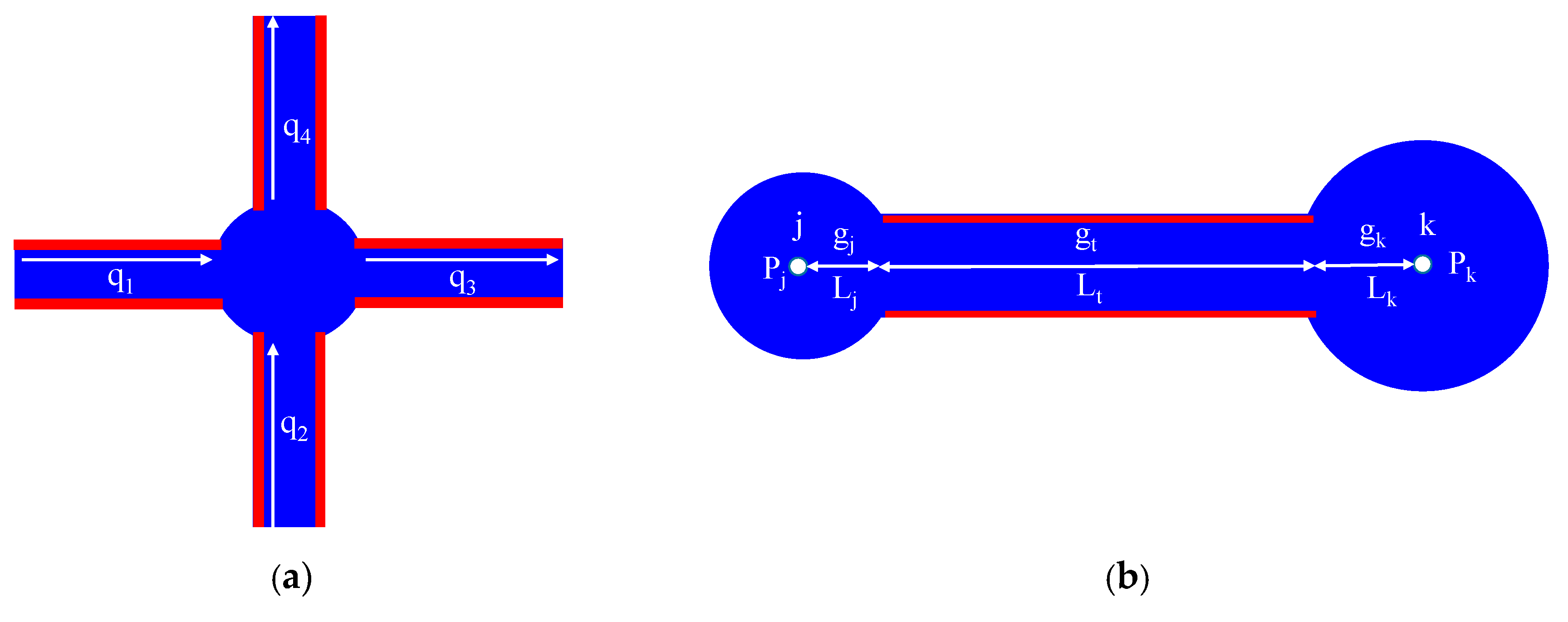
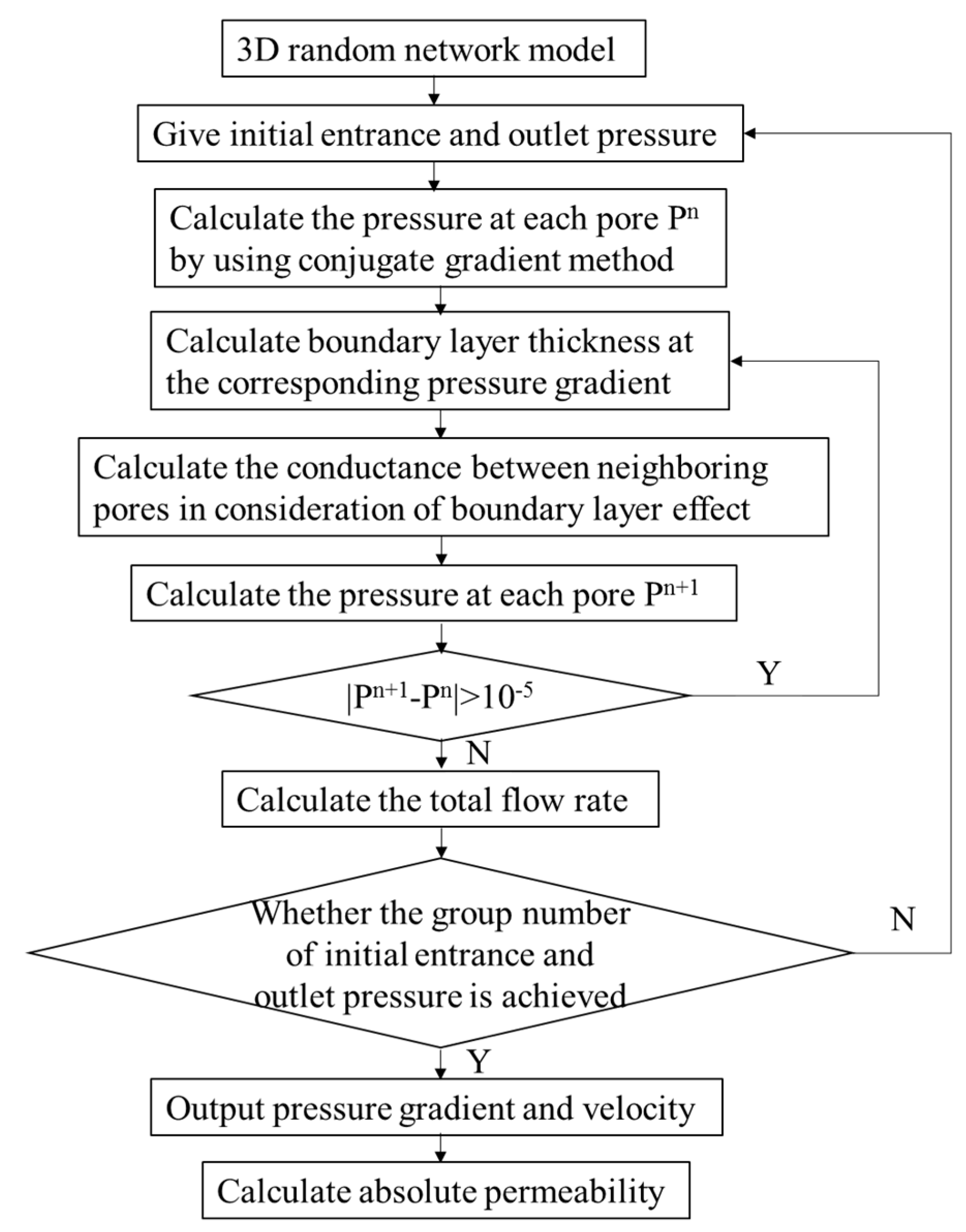


| Radius (μm) | b | c |
|---|---|---|
| 2.62 | 0.7187 | 0.486 |
| 5.62 | 1.199 | 0.3372 |
| 6.79 | 1.527 | 0.284 |
| 10.03 | 2.77 | 0.1712 |
| Constant Radius of Micro Tube | Constant Displacement Pressure Gradient | ||
|---|---|---|---|
| Fluid viscosity (mPa·s) | 0.92 | Fluid viscosity (mPa·s) | 0.92 |
| Radius (μm) | 5 | ∇P (MPa/m) | 0.5 |
| Parameters | Values | Parameters | Values |
|---|---|---|---|
| Model size | 10 × 10 × 10 | Throat radius (μm) | 1–4 |
| Pore radius (μm) | 10–100 | Throat length (μm) | 30–40 |
| Fluid viscosity (mPa s) | 0.92 |
© 2018 by the authors. Licensee MDPI, Basel, Switzerland. This article is an open access article distributed under the terms and conditions of the Creative Commons Attribution (CC BY) license (http://creativecommons.org/licenses/by/4.0/).
Share and Cite
Chen, M.; Cheng, L.; Cao, R.; Lyu, C. A Study to Investigate Fluid-Solid Interaction Effects on Fluid Flow in Micro Scales. Energies 2018, 11, 2197. https://doi.org/10.3390/en11092197
Chen M, Cheng L, Cao R, Lyu C. A Study to Investigate Fluid-Solid Interaction Effects on Fluid Flow in Micro Scales. Energies. 2018; 11(9):2197. https://doi.org/10.3390/en11092197
Chicago/Turabian StyleChen, Mingqiang, Linsong Cheng, Renyi Cao, and Chaohui Lyu. 2018. "A Study to Investigate Fluid-Solid Interaction Effects on Fluid Flow in Micro Scales" Energies 11, no. 9: 2197. https://doi.org/10.3390/en11092197
APA StyleChen, M., Cheng, L., Cao, R., & Lyu, C. (2018). A Study to Investigate Fluid-Solid Interaction Effects on Fluid Flow in Micro Scales. Energies, 11(9), 2197. https://doi.org/10.3390/en11092197




